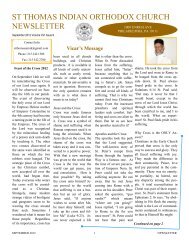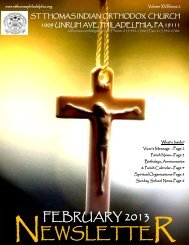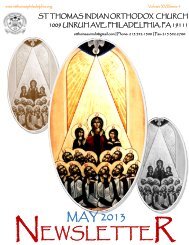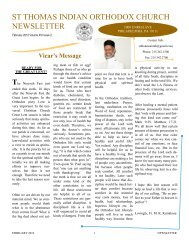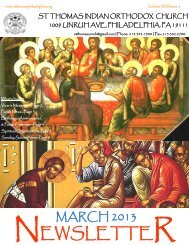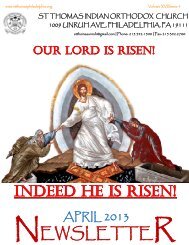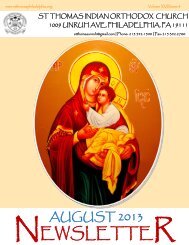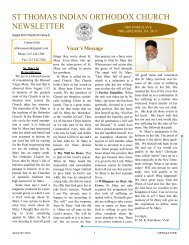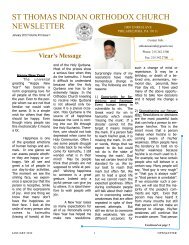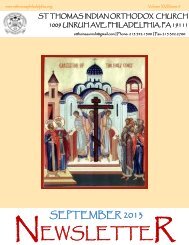Meditation Shrine Brochure - St. Thomas Philadelphia
Meditation Shrine Brochure - St. Thomas Philadelphia
Meditation Shrine Brochure - St. Thomas Philadelphia
Create successful ePaper yourself
Turn your PDF publications into a flip-book with our unique Google optimized e-Paper software.
<strong>St</strong>. Mary, Mother of God<br />
Dr.Yuhanon Mar Dimitrios (Metropolitan,Diocese of Delhi)<br />
Among all the saints of the Church, <strong>St</strong>. Mary occupies a preeminent position. This<br />
prominence is the consequence of her role as the Mother of God (Theotokos), a title that was<br />
underscored by the Ecumenical Council of Ephesus (A.D. 431) and firmly establishing it in<br />
the spirituality of the Church. <strong>St</strong>. Mary thus appears not only as the person who was favoured<br />
to bear the Son of God, but because of her acquiescence to God’s offer, she represents the<br />
pinnacle of synergy, the process by which human beings cooperate with God for the advancement<br />
of the salvific plan. Thus, she represents the reversal of the fatal fall of Eve in the Garden<br />
of Eden, and so is also given the designation “the second Eve.” The concept and role of<br />
<strong>St</strong>. Mary in the Malankara Orthodox Church can be appreciated only in the connection with its<br />
Christology and ecclesiology.<br />
While the Holy Scriptures do not contain this information, the Church tradition<br />
names <strong>St</strong>.Mary’s parents as Joachim and Anna, information contained in the Protevangelium<br />
of <strong>St</strong>.James. Her early years are shrouded in silence, except for the generalized picture that she<br />
was resident in the Jerusalem Temple. From this point the New Testament informs us that she received the annunciation of the birth<br />
of the Son of God (Lk 1: 2ff ), a point obliquely stated in <strong>St</strong>. Matthew’s infancy narrative (Mt.1:20) <strong>St</strong>.Luke very succinctly suggests<br />
that many of <strong>St</strong>.Mary’s experiences went past her comprehension, and it was only the passage of time that unpacked their significance<br />
for her (Lk 2:19, 50-51). Both <strong>St</strong>.Matthew and <strong>St</strong>.Luke record that she was affianced to Joseph who belonged to David’s family.<br />
It is in this way that Jesus’ ancestry is ultimately traced to the Davidic line. <strong>St</strong>.Matthew’s narrative <strong>St</strong>.Mt 2:1ff) has King Herod<br />
making an attempt on the life of the young Jesus, occasioned by the arrival and query of the Wise Men. Operating through a divine<br />
revelation, <strong>St</strong>.Joseph takes the mother Mary and the little Jesus and flees to Egypt. A revelation in a dream at a later stage conveys<br />
the death of those who sought the life of Jesus and so <strong>St</strong>.Joseph returns with <strong>St</strong>.Mary and the child to their native country and opt to<br />
settle in Nazareth for fear of Herod’s son who now controlled Judea. <strong>St</strong>.Luke alone records the event of <strong>St</strong>.Joseph and <strong>St</strong>.Mary taking<br />
the young Jesus to Jerusalem to attend the Passover and is somehow lost. After three days the parents return to find Jesus discussing<br />
with the teachers.<br />
We do not glimpse too many occasions when <strong>St</strong>.Mary is sighted during Jesus’ public ministry. There is the anecdote of how<br />
she, accompanied by other family members, attempt to obtain a meeting with him, which Jesus supposedly does not acquiesce to.<br />
<strong>St</strong>.John, however, has the narrative of Jesus, along with his disciples and <strong>St</strong>.Mary attending a marriage feast at Cana and during the<br />
course of which the wine runs out. <strong>St</strong>. Mary intercedes with her Son Jesus, the consequence of which leads to the transformation of<br />
the water held in six stone jars into the most qualitatively superlative wine. We then find references to <strong>St</strong>.Mary only during the last<br />
hours of Jesus when she is numbered among the women who watch his crucifixion. <strong>St</strong>.John has the poignant story of committing her<br />
to the care of his Beloved Disciple, an indication that by this time she had no family to look after her.<br />
The increase in the respect and reverence to <strong>St</strong>.Mary in consequence of her developing faith, which is seen in Acts<br />
of the Apostles, is continued in the early Church. And it is on the basis of the popular devotion to her that the Second Ecumenical<br />
Council held at Ephesus in A.D. 431 declared that <strong>St</strong>.Mary be addressed as the “Mother of God” (theotokos). It must be borne in<br />
mind that <strong>St</strong>.Cyril of Alexandria’s opposition to Nestorius’ advocacy for the use Mother of Christ (christotokos), the controversy<br />
that consitututes the background for this ecumenical council was based not only on this popular piety, but also on the sound theological<br />
principle that what was in question was more than a mere use of a term. What was at stake was the very foundation of the belief<br />
that God had become man. In pursuing the belief that Christ was fully God and fully man, the Alexandrian Church father stressed<br />
that to address <strong>St</strong>.Mary as merely the Mother of Christ alone sundered this unitive concept.<br />
This high reverence for <strong>St</strong>.Mary forms the underpinnings for the Orthodox Church’s hymns which extol her as the Second<br />
Eve and a second heaven. Many of the hymns use the events of the Old Testament to interpret the mystery of how God could have<br />
become a human through the agency of <strong>St</strong>.Mary. For instance, a favourite event is to interpret the appearance of God to Moses in the<br />
burning bush as a type of how Christ was incarnated; just as God appeared as a fire in the bush, but the bush was not consumed, so<br />
also Christ was born of <strong>St</strong>.Mary without consuming her. And since Christ is borne by the Cherubim in heaven, so also <strong>St</strong>.Mary is<br />
figured as a second heaven because she bore the Son of God. In all these instances, what is stressed is <strong>St</strong>.Mary’s obedience and submission<br />
to the will of God, thus reversing the disobedience and self-oriented character of the first Eve which paved for humankind’s<br />
fall into sin.<br />
The Orthodox Church holds it as part of its faith article that <strong>St</strong>.Mary continued to be a virgin all her life, addressing her as<br />
the Virgin Mary or the Virgin Mother. It believes that the Holy Scriptures do not contradict this belief and interprets the statements<br />
4 Sunday, December 23, 2012



